 |
|
|
A Week in
Basalt & Lava Friday-Saturday, March 9-17, 2012 by Dennis Foster
Part I: Getting to Lava Rapids (Pre-hike through Day 4) |
|
|
|
|
 |
|
|
A Week in
Basalt & Lava Friday-Saturday, March 9-17, 2012 by Dennis Foster
Part I: Getting to Lava Rapids (Pre-hike through Day 4) |
|
|
|
|
|
|
|
|
See Bill Ferris' trip report at his website - Grand Canyon Adventure
|
|
|
|
||
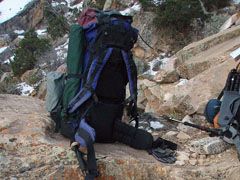 The kayak pack with overnight gear. |
 Camp at Tanner Delta. |
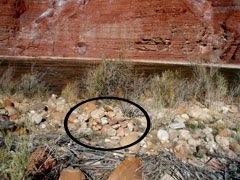 Kayak cache under "cairn." |
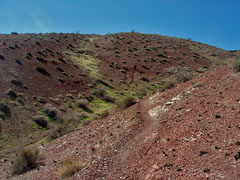 Bill heads up through the Dox. |
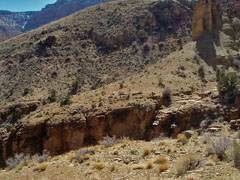 Trail climbs into BA shale. |
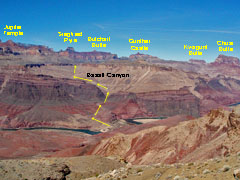 Looking back at proposed route. |
|
Day 2 - A Day at Basalt (Saturday, March 10) - I slept very well and got up rather late - at about 8 a.m. Since we decided to spend another night here, there wasn't any real rush to get up and get going. We got a chance to continue drying out our stuff while we poked around the Basalt delta area. We found the old miner's camp and there is is still quite a bit there. We also looked over the hillside we are camped above where pot shards are exposed. I don't think I've been to a site that had more bits and pieces than I have seen here. We also found an old nail sticking into the ground on the hill leading down to where we had tied up the kayak. At a bit past noon we were ready to take the kayak back across the river to convince ourselves that we could do this without calamity. We went along the shore up above the eddy and the beginning of this calm channel behind the island for our launch. Success! We maneuvered ourselves to the south side of the river, landing at our camping spot downriver a bit. Then we picked up the kayak and carried it back to the spot where we had launched the day before. This time we stayed in the river and below the eddy, landing on the island just below the calm channel. We got out and looked around this area for a while hoping we might find either Bill's hat or the other kayak seat, but we came up empty on that score. We crossed the calm channel and cached the kayak near to where we would use it to cross back over the river at the end of our trip. When we got back to camp the ravens were attacking our gear. We carry a couple of ratsacks to keep our food safe but the ravens were able to pick through the wire mesh and get into a couple of my meals. All in all it was only minor damage, so the ratsacks did do their job. We just kicked around the rest of this warm day, prepping for tomorrow's hike to Chuar Valley. |
|
|
||
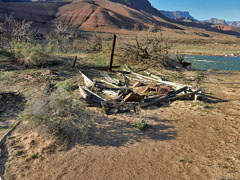 Old miners' camp at Basalt. |
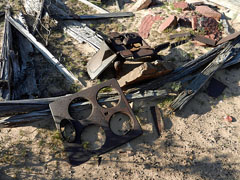 Stove at old camp. |
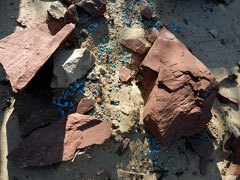 Odd looking blue pellets. |
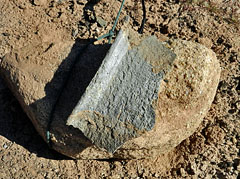 Lip fragment of old pot. |
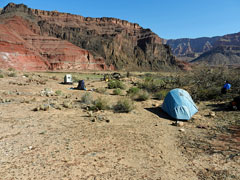 Our camp at Basalt. |
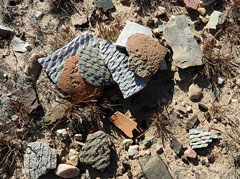 Pot shards near our campsite. |
 Old nail. |
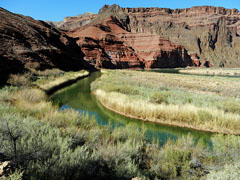 Backwater channel at Basalt. |
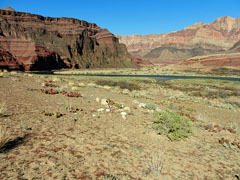 Terrace at Basalt (see our camp). |
|
|
||
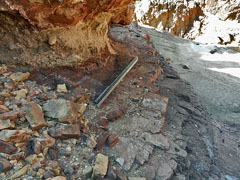 Metal posts - will NPS close mine? |
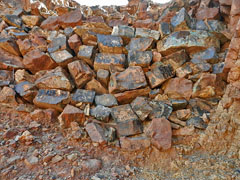 Retaining wall meant I was there! |
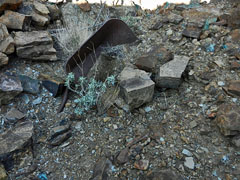 An old wheelbarrow remains. |
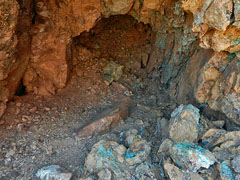 Shallow (caved in?) adit. |
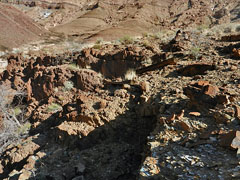 Cairn and timbers (looking north). |
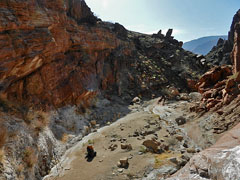 Mine site from bed (annotated). |
|
*See
Quest for the Pillar of Gold (Billingsley, Spamer, Menkes), p. 77. |
||
|
Up above the falls/mine the bed widens out into a valley. Walking along the trickle of water gets more difficult as it both narrows down and get brushy. We left the bed and paralleled it to the sloping Supergroup that provides a flat, if steep, ascent to the upper valley, above the two branches of Basalt. We only got part way up this route before we decided (at about 11:30 a.m.) to break for lunch in the shade of some cottonwood trees. That was a welcome break from what was turning out to be a rather hot day. We were on our way by 12:15 p.m. and to the top of the sloping rock a half hour later. On the map, this trek up through Basalt doesn't look very hard, but it was a grind for us. We mostly followed the bed in the upper valley although some detouring around boulder fields is necessary. As we neared the top we were in some really cool little narrows. We reached the saddle at about 3:30 p.m. I had twice hiked from Chuar/Lava to Basalt, but never via this route. Bill scouted around and found a spot that looked best for getting through the upper cliff layer. There were a few times where we had to step down through some steep places, but we were soon seeing signs of a game trail. And, of ancient use, when Bill spotted a large pottery piece that still had part of the lip intact. The route down was not only steep, but we were being eaten alive by the bugs. It was quite a challenge to swing my arms to keep them out of my ears, nose, mouth and eyes and yet pay attention to my footing! It took us exactly two hours to reach the creek at the so-called "Still Spring." We picked the right lines of descent and ended up in that ravine which we followed to the creek. [Later we would discover an easier route along the hilltops beside this ravine.] In my notes, I wrote, "Tired! Tired! Tired!" I guess I was tired. The bugs were mostly gone, but had been replaced by mosquitoes. And, giant ones at that! I decided to eat my dinner in my tent to keep them at bay. As it got dark and cooled down they disappeared. I thought that I finally turned in for the night at 9:30 p.m. but found out the next day that my phone and camera were giving me daylight savings times, which is not observed in most of Arizona. [So, it was actually 8:30 p.m. and mostly I was keeping track of the time from my watch.] |
|
Day 4 - Down to the Colorado River at Lava (Monday, March 12) - We were up and about a bit late. The first order of business was to find the remains of the old still. At 9 a.m. we poked around just downstream of our camp and found it right off the bat - wood planks, barrel hoops and miscellaneous scrap. Bill found the old coffee grinder right next to the creek and being consumed by a tree. This was one of the places I especially wanted to see. I had been in this area in 1984 (on my way to Phantom), in 1994 (just to visit in the Lava area) and 1996 (also on my way to Phantom) and completely missed this. I am quite sure that I must have walked right by the old coffee grinder on each occasion!! [Actually, I was also here in 1993, on my way to Phantom, but never got up this far in Lava.] Why would miners have a coffee grinder? Well, here's what a group of park rangers thought when they visited here in 1928:
The "small branch stream" must have been the same one that Bill and I came down to the creek. Is the ranger speculation right about the grinder? I think so, but I have also found a piece of a similar grinder, as best I can tell, above Bedrock Tanks on the South Bass Trail (see here for the picture and here for that trip report). Perhaps it is worth a note about the naming conventions here. The whole canyon here is called "Chuar Valley". There is a "Chuar Creek", but it is just a branch (and, dry I think) of the main creek which flows from the head of the canyon and all the way to the river and which is called "Lava Creek." The narrow section over the last mile to the river is called "Lava Canyon." At the river are two buttes - to the north is "Chuar Lava Hill" and to the south is "Lava Butte." The rapids at the river are called "Lava Canyon Rapids." There is also a "Chuar Butte" that defines the northeast corner of this valley and sits opposite the Little Colorado River. Even my head is spinning trying to keep track of all this. Right behind the old miner's camp we also found a faint trail that headed up to the higher terrace/plateau that is a dominant feature in this area. I went up a ways and could see that I would have clear sailing to the routes I was interested in checking out tomorrow that lead up to the top of the cliff between Lava and Basalt. At about 10:30 a.m. Bill headed down the creek to the river. I left a half hour later and met up with him there at 12:40 p.m. It was nice and relaxing hanging out at the river and so we whiled away the afternoon, not heading back until 3 p.m. We were back in camp at 4:45 p.m. I had set out a water bag to warm up in the sun all day and took a shower, which felt great. I had lasagna for dinner and we split a package of Bananas Foster for dessert. Ah, life is good! By the time I turned in I was pretty well packed up for the day hike I had planned for Tuesday. |
|
|
||
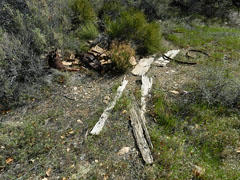 Miners' camp remains. |
 Miners' camp. |
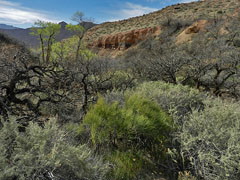 Area near miners' camp. |
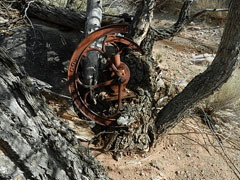 Grinder nearby. |
 Grinder. [Really for coffee???] |
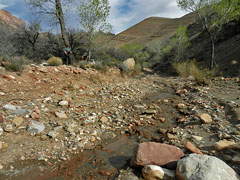 Bill at grinder beside Lava Creek. |
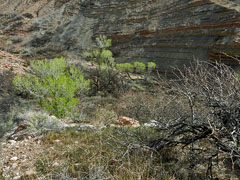 View of our camp from higher terrace. |
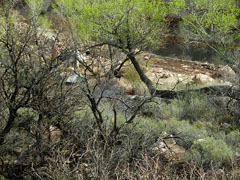 Close up of camp (note tents). |
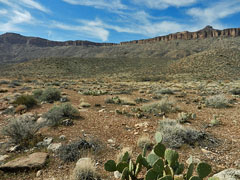 Looking to ridge towards Basalt. |
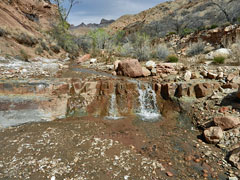 Lava Creek. |
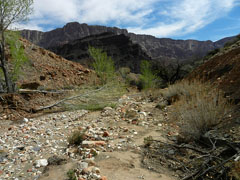 Chuar Lava Hill near river. |
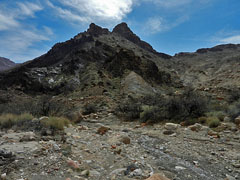 Mine tailings on Lava Butte. |
 Colorado River at Palisades. |
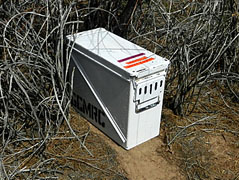 Hiker cache for river pick-up. |
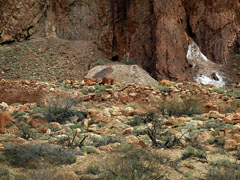 Mine tailings in Palisades. |
Go to Basalt & Lava - Part II: In Lava and Back Again |
||
|
|
||
|
|
Return to Hiking Grand Canyon home page |
|